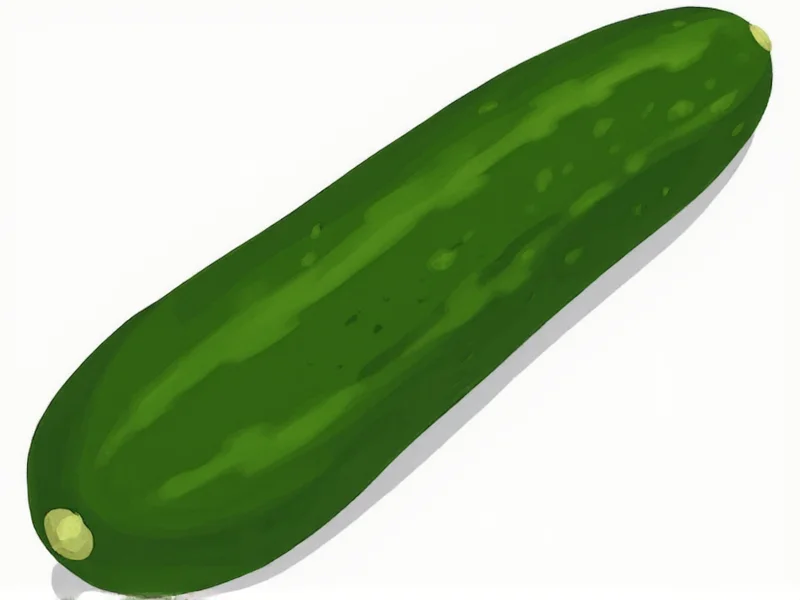Understanding the distinction between cucumbers and pickles is essential for both culinary applications and nutritional awareness. While all pickles start as cucumbers, not all cucumbers become pickles. This fundamental relationship often causes confusion, especially when encountering different varieties at the grocery store.
| Characteristic | Cucumber | Pickle |
|---|---|---|
| Nature | Fresh vegetable | Preserved food product |
| Preparation | Eaten raw, unprocessed | Soaked in vinegar or salt brine with spices |
| Taste | Mild, slightly sweet, refreshing | Tangy, sour, often with added spice flavors |
| Texture | Crisp, high water content (95%) | Firmer, less watery, varying crunch levels |
| Nutritional Profile | Low calorie, good vitamin K and potassium | Higher sodium, potential probiotics, reduced vitamin content |
| Shelf Life | 1-2 weeks refrigerated | Months to years when properly canned |
| Culinary Use | Salads, fresh preparations, hydration | Condiments, sandwiches, snacks, cooking ingredient |
The Pickling Process: Transformation Explained
The journey from cucumber to pickle involves a scientific preservation method that has been used for thousands of years. When cucumbers are submerged in a vinegar-based solution or saltwater brine, several chemical changes occur. The acid in vinegar or the lactic acid produced during fermentation lowers the pH, creating an environment where harmful bacteria cannot survive while beneficial bacteria may thrive.
Professional picklers typically use specific cucumber varieties bred for pickling, such as Kirby or Persian cucumbers, which have thinner skins and less water content than standard slicing cucumbers. These varieties maintain better texture during the pickling process. The addition of spices like dill, garlic, mustard seeds, and peppercorns creates the distinctive flavor profiles associated with different pickle types.
Types of Pickles and Their Characteristics
Not all pickles are created equal. The term "pickle" encompasses various preservation methods and flavor profiles:
- Fermented pickles: Created through lacto-fermentation where cucumbers sit in saltwater brine for weeks, allowing natural bacteria to produce lactic acid
- Vinegar pickles: Quickly prepared by submerging cucumbers in vinegar solution, producing immediate results
- Dill pickles: Flavored with dill weed and often garlic
- Sweet pickles: Contain added sugar in the pickling solution
- Bread and butter pickles: A sweet and sour variety with onions
- Gherkins: Made from small, bumpy cucumbers specifically grown for pickling
Nutritional Differences Worth Noting
While cucumbers and pickles share a common origin, their nutritional profiles differ significantly. A medium raw cucumber contains approximately 16 calories, 2.1 grams of carbohydrates, and provides about 14% of the daily recommended intake of vitamin K. Pickles, however, undergo notable changes during preservation.
The pickling process typically increases sodium content dramatically. A single dill pickle spear can contain 300-500mg of sodium compared to just 2mg in a similar portion of fresh cucumber. Some fermented pickles may contain beneficial probiotics, though this depends on whether the pickles have been pasteurized. The vinegar used in pickling may offer some metabolic benefits, though research is ongoing in this area.
It's important to note that while pickles lose some water-soluble vitamins during processing, they retain many beneficial compounds. Both cucumbers and pickles remain low-calorie food options that can contribute to a healthy diet when consumed appropriately.
Common Misconceptions Clarified
Several myths persist about the relationship between cucumbers and pickles. One widespread misconception is that pickles are a different vegetable species than cucumbers. In reality, pickles are simply cucumbers that have been preserved. Another common confusion involves gherkins, which many people believe are a separate vegetable. Gherkins are actually a specific variety of cucumber (Cucumis sativus) that's smaller and bumpier than standard cucumbers, specifically cultivated for pickling.
The phrase "cool as a cucumber" versus "in a pickle" reflects the cultural perception of these foods. While cucumbers symbolize calmness and refreshment, pickles represent a difficult situation - an interesting linguistic contrast considering their biological relationship.
Practical Applications in Cooking
Understanding the difference between cucumbers and pickles helps in making appropriate culinary choices. Fresh cucumbers work best in salads, cold soups, and as hydrating snacks. Their high water content makes them excellent for summer dishes but unsuitable for applications requiring firm texture over time.
Pickles, with their preserved nature and distinctive flavors, serve as excellent condiments, sandwich toppings, and cocktail ingredients. The acidity of pickles can cut through rich flavors in dishes, making them valuable components in balanced meal planning. Some chefs even use pickle brine in marinades and dressings to add complexity to various dishes.
Are pickles just cucumbers in vinegar?
Pickles are cucumbers that have been preserved through pickling, which typically involves submersion in vinegar or saltwater brine with spices. While vinegar is commonly used, traditional pickling can also occur through lacto-fermentation in saltwater brine without vinegar.
Can you turn any cucumber into a pickle?
While technically possible to pickle any cucumber, specific varieties like Kirby or Persian cucumbers work best for pickling due to their smaller size, firmer texture, and thinner skins. Standard slicing cucumbers often become too soft during the pickling process.
Why are some pickles crunchy while others are soft?
The crunchiness of pickles depends on several factors including cucumber variety, freshness, pickling method, and additives. Crisp pickles often result from using fresh, firm cucumbers, adding tannin-rich ingredients like grape leaves, and proper temperature control during processing.
Do pickles have probiotic benefits like other fermented foods?
Fermented pickles (those made with saltwater brine rather than vinegar) that haven't been pasteurized may contain beneficial probiotics. However, most commercially available pickles in supermarkets have been pasteurized, which kills both harmful and beneficial bacteria.
Are pickles healthier than cucumbers?
Both have nutritional benefits but with important differences. Cucumbers have significantly less sodium and more certain vitamins, while pickles may offer probiotics (if fermented and unpasteurized) and the potential metabolic benefits of vinegar. The healthiest choice depends on individual dietary needs and restrictions.











 浙公网安备
33010002000092号
浙公网安备
33010002000092号 浙B2-20120091-4
浙B2-20120091-4